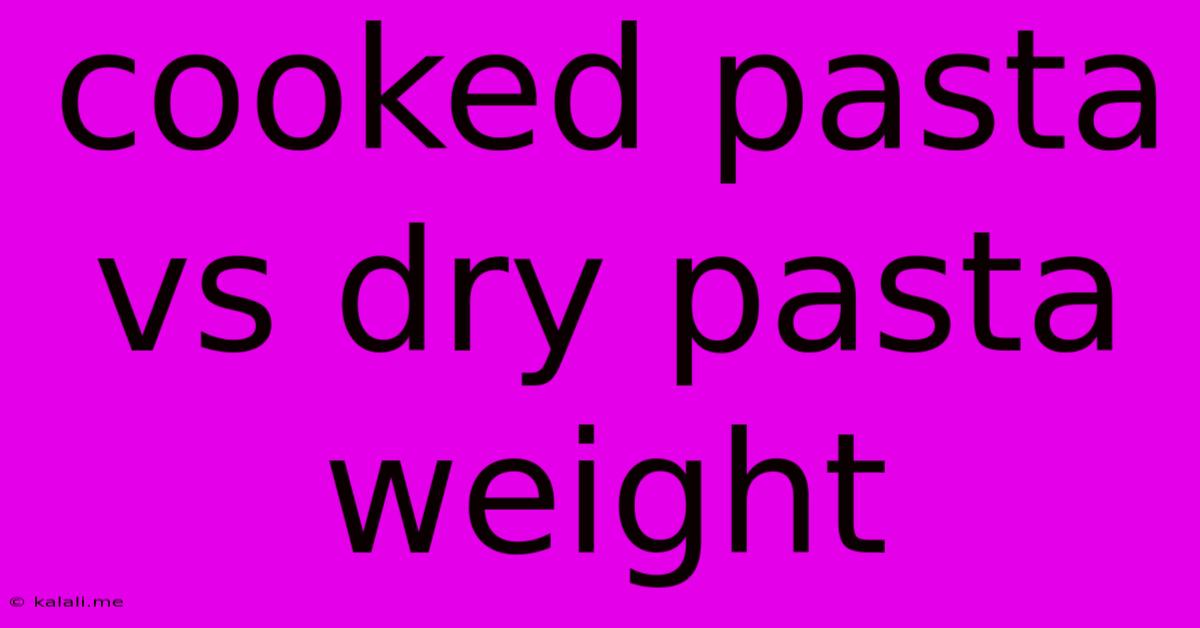Cooked Pasta Vs Dry Pasta Weight
Kalali
May 21, 2025 · 3 min read

Table of Contents
Cooked Pasta vs. Dry Pasta Weight: A Comprehensive Guide
Knowing the difference between cooked and dry pasta weight is crucial for accurate recipe measurements and achieving the perfect pasta dish. This guide clarifies the weight discrepancies and offers tips for consistent results, ensuring your pasta creations are always delicious. Understanding the weight variations will help you avoid a too-soupy or overly-dry pasta outcome.
The Significant Difference: Dry pasta absorbs a considerable amount of water during the cooking process, significantly increasing its weight. This water absorption is why cooked pasta weighs much more than its dry counterpart. The exact increase depends on the pasta shape, cooking time, and the type of pasta (e.g., whole wheat pasta absorbs more water than regular pasta). As a general rule, expect cooked pasta to weigh approximately 2 to 3 times more than its dry weight.
Understanding the Water Absorption Factor
Several factors contribute to the variable water absorption rate in pasta:
- Pasta Shape: Long pasta shapes like spaghetti or linguine generally absorb less water compared to shorter shapes like penne or farfalle. Their surface area differs, influencing water uptake.
- Cooking Time: Overcooking leads to excessive water absorption, resulting in mushy pasta. Following package instructions closely is vital for optimal texture and weight.
- Type of Pasta: Whole wheat pasta, due to its higher fiber content, tends to absorb more water than refined pasta.
Practical Implications in Cooking
The difference in weight significantly impacts recipe planning. If a recipe calls for a specific weight of cooked pasta, using dry pasta weight will lead to inaccurate measurements and potentially affect the final outcome. For example, a recipe requesting 500g of cooked pasta will require significantly less dry pasta.
Converting Dry Pasta Weight to Cooked Pasta Weight: A Guide
Precise conversion is difficult due to the variability mentioned above. However, you can use these guidelines:
- Rule of Thumb: A general rule is to multiply the dry weight by 3 to estimate the cooked weight. However, this is only an approximation.
- Weighing the Cooked Pasta: The most accurate method is to weigh your cooked pasta after draining it. This ensures precision and eliminates guesswork.
- Recipe Adjustments: Always err on the side of caution. Start with less dry pasta than you initially estimate, and you can always add more if needed.
Why Accurate Pasta Weight Matters
Beyond the texture and consistency of your dish, accurately measuring pasta weight impacts:
- Sauce Ratio: The correct pasta-to-sauce ratio is essential for a balanced flavor profile. Using inaccurate measurements can lead to an imbalance, resulting in a dish that's too dry or too saucy.
- Nutritional Calculations: Accurate measurement is essential for precise nutritional analysis and tracking, particularly when controlling portions or managing dietary restrictions.
Conclusion: Precision is Key
While there's no magic formula for converting dry to cooked pasta weight, focusing on accurate measurements and understanding the variables involved will drastically improve your cooking outcomes. Weighing your cooked pasta remains the most reliable method. By consistently using this approach, you'll elevate your pasta dishes to a new level of perfection. Remember, practice and attention to detail are key ingredients to success in the kitchen!
Latest Posts
Latest Posts
-
What Can Go Down A Chimney Up
May 21, 2025
-
How To Remove Vinyl Tile Adhesive
May 21, 2025
-
Why Does My Kitten Keep Licking Me
May 21, 2025
-
On Their Website Or In Their Website
May 21, 2025
-
Personal Forms Of Approval Crossword Clue
May 21, 2025
Related Post
Thank you for visiting our website which covers about Cooked Pasta Vs Dry Pasta Weight . We hope the information provided has been useful to you. Feel free to contact us if you have any questions or need further assistance. See you next time and don't miss to bookmark.